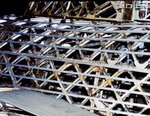FLYBOYJ
"THE GREAT GAZOO"
Wood structures are easy to produce but hell to repair, especially in the field. to do a proper repair the surface has to be in a clean environment and sometimes during the curing of glues, you don't want moisture or dirt.Lunatic said:FLYBOYJ said:Lunatic said:Actually properly laminated wood holds up better against machine gun fire than aluminum. The down side is it is also heavier than metal.
That depends on the type of aluminum structure. If you're talking skins, maybe, if you're talking main structures, wing attach points which are usually 7075 aluminum or even steel, no way....
I'm talking about control surfaces such as ailerons, where aluminum skinning is streched over alluminum brackets of mimimal thickness.
But, even for the wings themselves, the Soviet's found that, barring fire, the wood usually was less susceptible to combat damage than the metal equivalent (example: Yak3 vs. Yak9).
Aluminum will always offer a very flexible repair. You could patch aluminum holes almost anywhere and the training of personnel to accomplish sheet metal repairs are minimal. The thing to look at with wood, being organic is susceptible to many other defects not readily apparent until it too late, where aluminum is forgiving and actually "tells you" when its failing.
As you say "skinning stretched" over brackets (ribs) could range in thickness up to .040 depending on the aircraft. Its quite easy to repair them, especially if a round goes right through. Each manufacturer comes up with a "Structural Repair Manual" that provides guidance for most repairs and takes the guess work out for the mechanic repairing the aircraft.
I'd take aluminum any day, you don't have to worry about shrinkage, temperature related problems and dry rot which will eventually creep up on wood structures, especially in a harsh environment...
I've worked with both and all I have to say id wood sucks! I'd work with aluminum anyday and would believe it is the superior material to work with in a WW2 combat enviornment,unless you're stuck with nothing else!!!





